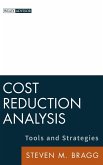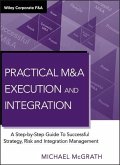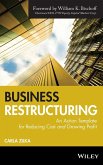Hauke Hansen, Wolfgang Huhn, Olivier Legrand, Daniel Steiners, Thomas Vahlenkamp
Capex Excellence
Optimizing Fixed Asset Investments
Hauke Hansen, Wolfgang Huhn, Olivier Legrand, Daniel Steiners, Thomas Vahlenkamp
Capex Excellence
Optimizing Fixed Asset Investments
- Gebundenes Buch
- Merkliste
- Auf die Merkliste
- Bewerten Bewerten
- Teilen
- Produkt teilen
- Produkterinnerung
- Produkterinnerung
Focusing on the core value levers companies can apply in the decision and design phase of capital investments, this book is the first to cover this topic in a holistic, practical, and strategic manner, and is based on McKinsey's extensive industry analysis and research. The book comprehensively examines the challenges in making decisions on capital investment. It includes many examples from seven asset-heavy industries: Utilities, Oil & Gas, Telecommunications, Transportation & Logistics, Chemicals, High Tech, and Automotive. Executive-level decision makers will appreciate this innovative toolbox for increasing return on assets.…mehr
Andere Kunden interessierten sich auch für
![Cost Reduction Analysis Cost Reduction Analysis]() Steven M BraggCost Reduction Analysis67,99 €
Steven M BraggCost Reduction Analysis67,99 €![Cash Flow Analysis and Forecasting Cash Flow Analysis and Forecasting]() Timothy JuryCash Flow Analysis and Forecasting69,99 €
Timothy JuryCash Flow Analysis and Forecasting69,99 €![Always a Winner Always a Winner]() Peter NavarroAlways a Winner30,99 €
Peter NavarroAlways a Winner30,99 €![Frequently Asked Questions in Corporate Finance Frequently Asked Questions in Corporate Finance]() Pascal QuiryFrequently Asked Questions in Corporate Finance42,99 €
Pascal QuiryFrequently Asked Questions in Corporate Finance42,99 €![Practical M&A Execution and Integration Practical M&A Execution and Integration]() Michael R McGrathPractical M&A Execution and Integration69,99 €
Michael R McGrathPractical M&A Execution and Integration69,99 €![Anti-Fraud Risk and Control Workbook Anti-Fraud Risk and Control Workbook]() Peter GoldmannAnti-Fraud Risk and Control Workbook63,99 €
Peter GoldmannAnti-Fraud Risk and Control Workbook63,99 €![Business Restructuring Business Restructuring]() Carla ZilkaBusiness Restructuring57,99 €
Carla ZilkaBusiness Restructuring57,99 €-
-
-
Focusing on the core value levers companies can apply in the decision and design phase of capital investments, this book is the first to cover this topic in a holistic, practical, and strategic manner, and is based on McKinsey's extensive industry analysis and research. The book comprehensively examines the challenges in making decisions on capital investment. It includes many examples from seven asset-heavy industries: Utilities, Oil & Gas, Telecommunications, Transportation & Logistics, Chemicals, High Tech, and Automotive. Executive-level decision makers will appreciate this innovative toolbox for increasing return on assets.
Hinweis: Dieser Artikel kann nur an eine deutsche Lieferadresse ausgeliefert werden.
Hinweis: Dieser Artikel kann nur an eine deutsche Lieferadresse ausgeliefert werden.
Produktdetails
- Produktdetails
- Verlag: John Wiley & Sons / Wiley
- Seitenzahl: 232
- Erscheinungstermin: 1. Juli 2009
- Englisch
- Abmessung: 249mm x 176mm x 25mm
- Gewicht: 570g
- ISBN-13: 9780470779675
- ISBN-10: 0470779675
- Artikelnr.: 26432362
- Herstellerkennzeichnung
- Libri GmbH
- Europaallee 1
- 36244 Bad Hersfeld
- gpsr@libri.de
- Verlag: John Wiley & Sons / Wiley
- Seitenzahl: 232
- Erscheinungstermin: 1. Juli 2009
- Englisch
- Abmessung: 249mm x 176mm x 25mm
- Gewicht: 570g
- ISBN-13: 9780470779675
- ISBN-10: 0470779675
- Artikelnr.: 26432362
- Herstellerkennzeichnung
- Libri GmbH
- Europaallee 1
- 36244 Bad Hersfeld
- gpsr@libri.de
Hauke Hansen works as a production manager for ASML in Veldhoven (NL). Prior to his current job he was an Associate Principal in McKinsey's Düsseldorf office. He served high-tech, telecom, logistics and telecom companies and supported several multi-billion dollar investment projects. He holds a PhD in physics from the University of Konstanz and was a Fulbright-scholar at the California Institute of Technology. Wolfgang Huhn is a Director in McKinsey's Frankfurt office. He primarily serves clients in the high tech industry as well as in energy. Wolfgang is a member of the Business Technology Office where he leads the industrial sector in Europe. He also leads the European Product Development Practice. Prior to joining McKinsey, Wolfgang studied electrical engineering and physics in Aachen and UK and obtained his PhD in Physics from the RWTH Aachen. From 1998 to 2000, Wolfgang was the CEO of a VC-backed company. Olivier Legrand is a Partner in McKinsey's Paris office. He serves clients in the transportation, steel and aluminum industries as well as in consumer goods and energy. Olivier co-leads McKinsey's global capital productivity group. Prior to joining McKinsey, Olivier spent four years with Air France in marketing research, marketing and sales positions. Olivier holds an MBA from Stanford Business School. Daniel Steiners is an Associate Principal in McKinsey's Düsseldorf office. He serves clients in electric power and chemicals across Europe and North America and is a co-leader of McKinsey's European capital productivity group. Daniel received a diploma in business administration from Muenster University and a PhD in management accounting from the European Business School in Oestrich-Winkel. Thomas Vahlenkamp is a Director in McKinsey's Düsseldorf office. He serves clients in the coal, oil, gas, power, and chemicals as well as transportation industries. Thomas is the sector leader of the Energy and Materials Practice in Germany and a member of the leadership group of the European Electric Power and Natural Gas Practice. His educational background is in polymer chemistry. He holds a degree from the Technical University of Aachen (RWTH) and a doctorate from the Max Planck Institute for Polymer Research.
Acknowledgements.
About the Authors.
PART I WHY INVESTMENTS MATTER.
1 Introduction.
1.1 Investments: the forgotten value lever.
1.1.1 The early bird catches the worm.
1.2 A bird's-eye view of the book content.
1.2.1 Part I: Why investments matter.
1.2.2 Part II: Getting investments right.
1.2.3 Part III: Right allocation: Managing a company's investment
portfolio.
1.3 Why investments matter: the importance and structure of capital
investments.
1.3.1 The relevance of capital investments.
1.3.2 The structure of capital investments.
1.3.3 Time dependence of capital investments.
1.3.4 The future of capital investments.
1.4 Summary.
Appendix 1.1: Wavelet analysis: Extracting frequency information from
investment timelines.
References.
PART II GETTING INVESTMENTS RIGHT.
2 Right Positioning: Managing an Asset's Exposure to Economic Risk.
2.1 Preface.
2.2 Asset exposure determines the achievable return on an investment.
2.3 Five levels of protection determine the asset exposure.
2.4 A simple scoring metric to measure asset exposure.
2.5 Quantitative asset exposure analysis shows high correlation with ROIC
at all levels.
2.5.1 Using exposure level analysis for benchmarking.
2.6 Strategies to reduce asset exposure.
2.6.1 Strategy 1: Create public-private, win-win situations in natural
monopoly environments.
2.6.2 Strategy 2: Foster regulatory conditions that enable sufficient
investment levels.
2.6.3 Strategy 3: Create the right structural conditions and ensure fair
access to scarce resources.
2.6.4 Strategy 4: Establish protection for intellectual property.
2.6.5 Strategy 5: Achieve a strong commercial position.
2.6.6 Strategy 6: Minimize fixed capital costs or outsource asset ownership
(go "asset light").
2.7 Summary.
3 Right Technology: How to Optimize Innovation Timing and Risks.
3.1 Capital investments in technology innovation.
3.1.1 Technology analysis.
3.1.2 Assess risks.
3.1.3 Mitigating technology risks.
3.2 Summary.
4 Right Timing: How Cyclicality Affects Return on Investments and What
Companies Can Do About It.
4.1 How cyclicality destroys value.
4.2 Industry drivers of cyclicality.
4.2.1 Impact of investment lead times.
4.2.2 Slow-to-no market growth.
4.2.3 High price sensitivity.
4.2.4 Investment timing with respect to the cycle.
4.3 Developing an economic model of cyclicality.
4.3.1 A fundamental law of economic cycles.
4.3.2 Base parameters of simple economic oscillations.
4.3.3 Reaction of cyclical systems to external "excitation".
4.3.4 Economic cycles with more than one player present.
4.4 Measures to cope with cyclicality.
4.4.1 Reaction delay.
4.4.2 Reaction strength.
4.4.3 "Jokers" that can help beat the cycle.
4.4.4 Where no joker is available.
4.5 Summary.
Appendix 4A: A differential equation for economic cyclicality.
Reference.
5 Right Size: Balancing Economies and Diseconomies of Scale.
5.1 Introduction: The role of scale in determining profitability.
5.2 Assessing economies of scale.
5.2.1 Fixed cost leverage.
5.2.2 Decreasing unit costs.
5.2.3 Equipment utilization/chunkiness of capacity.
5.2.4 Critical size.
5.3 Determining diseconomies of scale.
5.3.1 Cost elements.
5.4 Risk elements.
5.4.1 Utilization risks.
5.4.2 Market reaction risks.
5.4.3 Technology risks.
5.4.4 Timing risks.
5.5 An approach for finding the "sweet spot".
5.5.1 Scale effect model.
5.6 Real-life examples.
5.6.1 Automotive industry case example.
5.6.2 Base chemicals case example.
5.7 Summary.
Reference.
6 Right Location: Getting the Most from Government Incentives.
6.1 Government incentives: An overview.
6.1.1 Creating public-private, win-win situations.
6.2 Common types of incentive instruments.
6.2.1 Subsidies.
6.2.2 Financing support.
6.2.3 Tax relief.
6.2.4 Other types of government incentives.
6.3 The financial impact of incentives: A modeling approach.
6.3.1 General impact of subsidies.
6.3.2 General impact of financing support.
6.3.3 General impact of tax relief.
6.3.4 Specific impact of incentives on different industries.
6.4 Geographical differences in incentive structures.
6.5 Managing government incentives.
6.6 Summary.
References.
7 Right Design: How to Make Investments Lean and Flexible.
7.1 Lean design as a competitive advantage.
7.1.1 The lean way: Moving from capital investment projects to a lean
design system.
7.2 The three dimensions of a lean capital investment system.
7.3 Dimension 1: The technical system.
7.3.1 Start with project objectives, design princisples, and target
setting.
7.3.2 Value engineering and lean tools.
7.3.3 Design optimization.
7.3.4 From the basic design to start of production.
7.3.5 Anchoring tools and practices to formal standards.
7.4 Dimensions 2 & 3: Management infrastructure, mindset and behavior.
7.4.1 Project organization and performance management.
7.4.2 Institutionalization and learning.
7.4.3 Adapting the system to local specifics: Project design cannot be "one
size fits all".
7.4.4 Getting started.
7.5 Flexibility: Just what customers and the company need and no more.
7.5.1 Macro-level flexibility: modularity in plant design to ensure
flexible, cost-efficient assets.
7.5.2 Midi-level flexibility in plant design: cater for product portfolio
diversity.
7.5.3 Micro-level flexibility in plant design: design for iso-productivity.
7.6 How to avoid creating a front-page disaster: Anticipating what can go
wrong.
7.6.1 Performance management and decision making.
7.6.2 Tools which every company and project team need to master.
7.6.3 Cross-functional coordination.
7.7 Summary.
References.
8 Right Financing: Shaping the Optimal Finance Portfolio.
8.1 Why Financing Matters.
8.2 Three-Step Financing Approach.
8.2.1 Step 1: Evaluating the investment's cash flow parameters.
8.2.2 Step 2: Assessing investment risks.
8.2.3 Step 3: Composing the financing portfolio.
8.3 Summary.
References.
PART III.
9 Right Allocation: How to Allocate Money Within the Company.
9.1 Key requirements for capital allocation.
9.2 Four models of the corporate center role in shaping the investment
portfolio.
9.3 Capital allocation approach for operators and strategic controllers.
9.3.1 Step 1: Treat special projects as high priority.
9.3.2 Step 2: Allocate remaining capital to business units.
9.3.3 Step 3: Business units distribute capital to individual investments.
9.3.4 Step 4: Implement a capital assurance process.
9.3.5 Improving the "capital allocation key".
9.3.6 Capital allocation backbone.
9.4 Capital allocation approach for strategic architects and financial
holding structures.
9.5 Summary.
References.
Index.
About the Authors.
PART I WHY INVESTMENTS MATTER.
1 Introduction.
1.1 Investments: the forgotten value lever.
1.1.1 The early bird catches the worm.
1.2 A bird's-eye view of the book content.
1.2.1 Part I: Why investments matter.
1.2.2 Part II: Getting investments right.
1.2.3 Part III: Right allocation: Managing a company's investment
portfolio.
1.3 Why investments matter: the importance and structure of capital
investments.
1.3.1 The relevance of capital investments.
1.3.2 The structure of capital investments.
1.3.3 Time dependence of capital investments.
1.3.4 The future of capital investments.
1.4 Summary.
Appendix 1.1: Wavelet analysis: Extracting frequency information from
investment timelines.
References.
PART II GETTING INVESTMENTS RIGHT.
2 Right Positioning: Managing an Asset's Exposure to Economic Risk.
2.1 Preface.
2.2 Asset exposure determines the achievable return on an investment.
2.3 Five levels of protection determine the asset exposure.
2.4 A simple scoring metric to measure asset exposure.
2.5 Quantitative asset exposure analysis shows high correlation with ROIC
at all levels.
2.5.1 Using exposure level analysis for benchmarking.
2.6 Strategies to reduce asset exposure.
2.6.1 Strategy 1: Create public-private, win-win situations in natural
monopoly environments.
2.6.2 Strategy 2: Foster regulatory conditions that enable sufficient
investment levels.
2.6.3 Strategy 3: Create the right structural conditions and ensure fair
access to scarce resources.
2.6.4 Strategy 4: Establish protection for intellectual property.
2.6.5 Strategy 5: Achieve a strong commercial position.
2.6.6 Strategy 6: Minimize fixed capital costs or outsource asset ownership
(go "asset light").
2.7 Summary.
3 Right Technology: How to Optimize Innovation Timing and Risks.
3.1 Capital investments in technology innovation.
3.1.1 Technology analysis.
3.1.2 Assess risks.
3.1.3 Mitigating technology risks.
3.2 Summary.
4 Right Timing: How Cyclicality Affects Return on Investments and What
Companies Can Do About It.
4.1 How cyclicality destroys value.
4.2 Industry drivers of cyclicality.
4.2.1 Impact of investment lead times.
4.2.2 Slow-to-no market growth.
4.2.3 High price sensitivity.
4.2.4 Investment timing with respect to the cycle.
4.3 Developing an economic model of cyclicality.
4.3.1 A fundamental law of economic cycles.
4.3.2 Base parameters of simple economic oscillations.
4.3.3 Reaction of cyclical systems to external "excitation".
4.3.4 Economic cycles with more than one player present.
4.4 Measures to cope with cyclicality.
4.4.1 Reaction delay.
4.4.2 Reaction strength.
4.4.3 "Jokers" that can help beat the cycle.
4.4.4 Where no joker is available.
4.5 Summary.
Appendix 4A: A differential equation for economic cyclicality.
Reference.
5 Right Size: Balancing Economies and Diseconomies of Scale.
5.1 Introduction: The role of scale in determining profitability.
5.2 Assessing economies of scale.
5.2.1 Fixed cost leverage.
5.2.2 Decreasing unit costs.
5.2.3 Equipment utilization/chunkiness of capacity.
5.2.4 Critical size.
5.3 Determining diseconomies of scale.
5.3.1 Cost elements.
5.4 Risk elements.
5.4.1 Utilization risks.
5.4.2 Market reaction risks.
5.4.3 Technology risks.
5.4.4 Timing risks.
5.5 An approach for finding the "sweet spot".
5.5.1 Scale effect model.
5.6 Real-life examples.
5.6.1 Automotive industry case example.
5.6.2 Base chemicals case example.
5.7 Summary.
Reference.
6 Right Location: Getting the Most from Government Incentives.
6.1 Government incentives: An overview.
6.1.1 Creating public-private, win-win situations.
6.2 Common types of incentive instruments.
6.2.1 Subsidies.
6.2.2 Financing support.
6.2.3 Tax relief.
6.2.4 Other types of government incentives.
6.3 The financial impact of incentives: A modeling approach.
6.3.1 General impact of subsidies.
6.3.2 General impact of financing support.
6.3.3 General impact of tax relief.
6.3.4 Specific impact of incentives on different industries.
6.4 Geographical differences in incentive structures.
6.5 Managing government incentives.
6.6 Summary.
References.
7 Right Design: How to Make Investments Lean and Flexible.
7.1 Lean design as a competitive advantage.
7.1.1 The lean way: Moving from capital investment projects to a lean
design system.
7.2 The three dimensions of a lean capital investment system.
7.3 Dimension 1: The technical system.
7.3.1 Start with project objectives, design princisples, and target
setting.
7.3.2 Value engineering and lean tools.
7.3.3 Design optimization.
7.3.4 From the basic design to start of production.
7.3.5 Anchoring tools and practices to formal standards.
7.4 Dimensions 2 & 3: Management infrastructure, mindset and behavior.
7.4.1 Project organization and performance management.
7.4.2 Institutionalization and learning.
7.4.3 Adapting the system to local specifics: Project design cannot be "one
size fits all".
7.4.4 Getting started.
7.5 Flexibility: Just what customers and the company need and no more.
7.5.1 Macro-level flexibility: modularity in plant design to ensure
flexible, cost-efficient assets.
7.5.2 Midi-level flexibility in plant design: cater for product portfolio
diversity.
7.5.3 Micro-level flexibility in plant design: design for iso-productivity.
7.6 How to avoid creating a front-page disaster: Anticipating what can go
wrong.
7.6.1 Performance management and decision making.
7.6.2 Tools which every company and project team need to master.
7.6.3 Cross-functional coordination.
7.7 Summary.
References.
8 Right Financing: Shaping the Optimal Finance Portfolio.
8.1 Why Financing Matters.
8.2 Three-Step Financing Approach.
8.2.1 Step 1: Evaluating the investment's cash flow parameters.
8.2.2 Step 2: Assessing investment risks.
8.2.3 Step 3: Composing the financing portfolio.
8.3 Summary.
References.
PART III.
9 Right Allocation: How to Allocate Money Within the Company.
9.1 Key requirements for capital allocation.
9.2 Four models of the corporate center role in shaping the investment
portfolio.
9.3 Capital allocation approach for operators and strategic controllers.
9.3.1 Step 1: Treat special projects as high priority.
9.3.2 Step 2: Allocate remaining capital to business units.
9.3.3 Step 3: Business units distribute capital to individual investments.
9.3.4 Step 4: Implement a capital assurance process.
9.3.5 Improving the "capital allocation key".
9.3.6 Capital allocation backbone.
9.4 Capital allocation approach for strategic architects and financial
holding structures.
9.5 Summary.
References.
Index.
Acknowledgements.
About the Authors.
PART I WHY INVESTMENTS MATTER.
1 Introduction.
1.1 Investments: the forgotten value lever.
1.1.1 The early bird catches the worm.
1.2 A bird's-eye view of the book content.
1.2.1 Part I: Why investments matter.
1.2.2 Part II: Getting investments right.
1.2.3 Part III: Right allocation: Managing a company's investment
portfolio.
1.3 Why investments matter: the importance and structure of capital
investments.
1.3.1 The relevance of capital investments.
1.3.2 The structure of capital investments.
1.3.3 Time dependence of capital investments.
1.3.4 The future of capital investments.
1.4 Summary.
Appendix 1.1: Wavelet analysis: Extracting frequency information from
investment timelines.
References.
PART II GETTING INVESTMENTS RIGHT.
2 Right Positioning: Managing an Asset's Exposure to Economic Risk.
2.1 Preface.
2.2 Asset exposure determines the achievable return on an investment.
2.3 Five levels of protection determine the asset exposure.
2.4 A simple scoring metric to measure asset exposure.
2.5 Quantitative asset exposure analysis shows high correlation with ROIC
at all levels.
2.5.1 Using exposure level analysis for benchmarking.
2.6 Strategies to reduce asset exposure.
2.6.1 Strategy 1: Create public-private, win-win situations in natural
monopoly environments.
2.6.2 Strategy 2: Foster regulatory conditions that enable sufficient
investment levels.
2.6.3 Strategy 3: Create the right structural conditions and ensure fair
access to scarce resources.
2.6.4 Strategy 4: Establish protection for intellectual property.
2.6.5 Strategy 5: Achieve a strong commercial position.
2.6.6 Strategy 6: Minimize fixed capital costs or outsource asset ownership
(go "asset light").
2.7 Summary.
3 Right Technology: How to Optimize Innovation Timing and Risks.
3.1 Capital investments in technology innovation.
3.1.1 Technology analysis.
3.1.2 Assess risks.
3.1.3 Mitigating technology risks.
3.2 Summary.
4 Right Timing: How Cyclicality Affects Return on Investments and What
Companies Can Do About It.
4.1 How cyclicality destroys value.
4.2 Industry drivers of cyclicality.
4.2.1 Impact of investment lead times.
4.2.2 Slow-to-no market growth.
4.2.3 High price sensitivity.
4.2.4 Investment timing with respect to the cycle.
4.3 Developing an economic model of cyclicality.
4.3.1 A fundamental law of economic cycles.
4.3.2 Base parameters of simple economic oscillations.
4.3.3 Reaction of cyclical systems to external "excitation".
4.3.4 Economic cycles with more than one player present.
4.4 Measures to cope with cyclicality.
4.4.1 Reaction delay.
4.4.2 Reaction strength.
4.4.3 "Jokers" that can help beat the cycle.
4.4.4 Where no joker is available.
4.5 Summary.
Appendix 4A: A differential equation for economic cyclicality.
Reference.
5 Right Size: Balancing Economies and Diseconomies of Scale.
5.1 Introduction: The role of scale in determining profitability.
5.2 Assessing economies of scale.
5.2.1 Fixed cost leverage.
5.2.2 Decreasing unit costs.
5.2.3 Equipment utilization/chunkiness of capacity.
5.2.4 Critical size.
5.3 Determining diseconomies of scale.
5.3.1 Cost elements.
5.4 Risk elements.
5.4.1 Utilization risks.
5.4.2 Market reaction risks.
5.4.3 Technology risks.
5.4.4 Timing risks.
5.5 An approach for finding the "sweet spot".
5.5.1 Scale effect model.
5.6 Real-life examples.
5.6.1 Automotive industry case example.
5.6.2 Base chemicals case example.
5.7 Summary.
Reference.
6 Right Location: Getting the Most from Government Incentives.
6.1 Government incentives: An overview.
6.1.1 Creating public-private, win-win situations.
6.2 Common types of incentive instruments.
6.2.1 Subsidies.
6.2.2 Financing support.
6.2.3 Tax relief.
6.2.4 Other types of government incentives.
6.3 The financial impact of incentives: A modeling approach.
6.3.1 General impact of subsidies.
6.3.2 General impact of financing support.
6.3.3 General impact of tax relief.
6.3.4 Specific impact of incentives on different industries.
6.4 Geographical differences in incentive structures.
6.5 Managing government incentives.
6.6 Summary.
References.
7 Right Design: How to Make Investments Lean and Flexible.
7.1 Lean design as a competitive advantage.
7.1.1 The lean way: Moving from capital investment projects to a lean
design system.
7.2 The three dimensions of a lean capital investment system.
7.3 Dimension 1: The technical system.
7.3.1 Start with project objectives, design princisples, and target
setting.
7.3.2 Value engineering and lean tools.
7.3.3 Design optimization.
7.3.4 From the basic design to start of production.
7.3.5 Anchoring tools and practices to formal standards.
7.4 Dimensions 2 & 3: Management infrastructure, mindset and behavior.
7.4.1 Project organization and performance management.
7.4.2 Institutionalization and learning.
7.4.3 Adapting the system to local specifics: Project design cannot be "one
size fits all".
7.4.4 Getting started.
7.5 Flexibility: Just what customers and the company need and no more.
7.5.1 Macro-level flexibility: modularity in plant design to ensure
flexible, cost-efficient assets.
7.5.2 Midi-level flexibility in plant design: cater for product portfolio
diversity.
7.5.3 Micro-level flexibility in plant design: design for iso-productivity.
7.6 How to avoid creating a front-page disaster: Anticipating what can go
wrong.
7.6.1 Performance management and decision making.
7.6.2 Tools which every company and project team need to master.
7.6.3 Cross-functional coordination.
7.7 Summary.
References.
8 Right Financing: Shaping the Optimal Finance Portfolio.
8.1 Why Financing Matters.
8.2 Three-Step Financing Approach.
8.2.1 Step 1: Evaluating the investment's cash flow parameters.
8.2.2 Step 2: Assessing investment risks.
8.2.3 Step 3: Composing the financing portfolio.
8.3 Summary.
References.
PART III.
9 Right Allocation: How to Allocate Money Within the Company.
9.1 Key requirements for capital allocation.
9.2 Four models of the corporate center role in shaping the investment
portfolio.
9.3 Capital allocation approach for operators and strategic controllers.
9.3.1 Step 1: Treat special projects as high priority.
9.3.2 Step 2: Allocate remaining capital to business units.
9.3.3 Step 3: Business units distribute capital to individual investments.
9.3.4 Step 4: Implement a capital assurance process.
9.3.5 Improving the "capital allocation key".
9.3.6 Capital allocation backbone.
9.4 Capital allocation approach for strategic architects and financial
holding structures.
9.5 Summary.
References.
Index.
About the Authors.
PART I WHY INVESTMENTS MATTER.
1 Introduction.
1.1 Investments: the forgotten value lever.
1.1.1 The early bird catches the worm.
1.2 A bird's-eye view of the book content.
1.2.1 Part I: Why investments matter.
1.2.2 Part II: Getting investments right.
1.2.3 Part III: Right allocation: Managing a company's investment
portfolio.
1.3 Why investments matter: the importance and structure of capital
investments.
1.3.1 The relevance of capital investments.
1.3.2 The structure of capital investments.
1.3.3 Time dependence of capital investments.
1.3.4 The future of capital investments.
1.4 Summary.
Appendix 1.1: Wavelet analysis: Extracting frequency information from
investment timelines.
References.
PART II GETTING INVESTMENTS RIGHT.
2 Right Positioning: Managing an Asset's Exposure to Economic Risk.
2.1 Preface.
2.2 Asset exposure determines the achievable return on an investment.
2.3 Five levels of protection determine the asset exposure.
2.4 A simple scoring metric to measure asset exposure.
2.5 Quantitative asset exposure analysis shows high correlation with ROIC
at all levels.
2.5.1 Using exposure level analysis for benchmarking.
2.6 Strategies to reduce asset exposure.
2.6.1 Strategy 1: Create public-private, win-win situations in natural
monopoly environments.
2.6.2 Strategy 2: Foster regulatory conditions that enable sufficient
investment levels.
2.6.3 Strategy 3: Create the right structural conditions and ensure fair
access to scarce resources.
2.6.4 Strategy 4: Establish protection for intellectual property.
2.6.5 Strategy 5: Achieve a strong commercial position.
2.6.6 Strategy 6: Minimize fixed capital costs or outsource asset ownership
(go "asset light").
2.7 Summary.
3 Right Technology: How to Optimize Innovation Timing and Risks.
3.1 Capital investments in technology innovation.
3.1.1 Technology analysis.
3.1.2 Assess risks.
3.1.3 Mitigating technology risks.
3.2 Summary.
4 Right Timing: How Cyclicality Affects Return on Investments and What
Companies Can Do About It.
4.1 How cyclicality destroys value.
4.2 Industry drivers of cyclicality.
4.2.1 Impact of investment lead times.
4.2.2 Slow-to-no market growth.
4.2.3 High price sensitivity.
4.2.4 Investment timing with respect to the cycle.
4.3 Developing an economic model of cyclicality.
4.3.1 A fundamental law of economic cycles.
4.3.2 Base parameters of simple economic oscillations.
4.3.3 Reaction of cyclical systems to external "excitation".
4.3.4 Economic cycles with more than one player present.
4.4 Measures to cope with cyclicality.
4.4.1 Reaction delay.
4.4.2 Reaction strength.
4.4.3 "Jokers" that can help beat the cycle.
4.4.4 Where no joker is available.
4.5 Summary.
Appendix 4A: A differential equation for economic cyclicality.
Reference.
5 Right Size: Balancing Economies and Diseconomies of Scale.
5.1 Introduction: The role of scale in determining profitability.
5.2 Assessing economies of scale.
5.2.1 Fixed cost leverage.
5.2.2 Decreasing unit costs.
5.2.3 Equipment utilization/chunkiness of capacity.
5.2.4 Critical size.
5.3 Determining diseconomies of scale.
5.3.1 Cost elements.
5.4 Risk elements.
5.4.1 Utilization risks.
5.4.2 Market reaction risks.
5.4.3 Technology risks.
5.4.4 Timing risks.
5.5 An approach for finding the "sweet spot".
5.5.1 Scale effect model.
5.6 Real-life examples.
5.6.1 Automotive industry case example.
5.6.2 Base chemicals case example.
5.7 Summary.
Reference.
6 Right Location: Getting the Most from Government Incentives.
6.1 Government incentives: An overview.
6.1.1 Creating public-private, win-win situations.
6.2 Common types of incentive instruments.
6.2.1 Subsidies.
6.2.2 Financing support.
6.2.3 Tax relief.
6.2.4 Other types of government incentives.
6.3 The financial impact of incentives: A modeling approach.
6.3.1 General impact of subsidies.
6.3.2 General impact of financing support.
6.3.3 General impact of tax relief.
6.3.4 Specific impact of incentives on different industries.
6.4 Geographical differences in incentive structures.
6.5 Managing government incentives.
6.6 Summary.
References.
7 Right Design: How to Make Investments Lean and Flexible.
7.1 Lean design as a competitive advantage.
7.1.1 The lean way: Moving from capital investment projects to a lean
design system.
7.2 The three dimensions of a lean capital investment system.
7.3 Dimension 1: The technical system.
7.3.1 Start with project objectives, design princisples, and target
setting.
7.3.2 Value engineering and lean tools.
7.3.3 Design optimization.
7.3.4 From the basic design to start of production.
7.3.5 Anchoring tools and practices to formal standards.
7.4 Dimensions 2 & 3: Management infrastructure, mindset and behavior.
7.4.1 Project organization and performance management.
7.4.2 Institutionalization and learning.
7.4.3 Adapting the system to local specifics: Project design cannot be "one
size fits all".
7.4.4 Getting started.
7.5 Flexibility: Just what customers and the company need and no more.
7.5.1 Macro-level flexibility: modularity in plant design to ensure
flexible, cost-efficient assets.
7.5.2 Midi-level flexibility in plant design: cater for product portfolio
diversity.
7.5.3 Micro-level flexibility in plant design: design for iso-productivity.
7.6 How to avoid creating a front-page disaster: Anticipating what can go
wrong.
7.6.1 Performance management and decision making.
7.6.2 Tools which every company and project team need to master.
7.6.3 Cross-functional coordination.
7.7 Summary.
References.
8 Right Financing: Shaping the Optimal Finance Portfolio.
8.1 Why Financing Matters.
8.2 Three-Step Financing Approach.
8.2.1 Step 1: Evaluating the investment's cash flow parameters.
8.2.2 Step 2: Assessing investment risks.
8.2.3 Step 3: Composing the financing portfolio.
8.3 Summary.
References.
PART III.
9 Right Allocation: How to Allocate Money Within the Company.
9.1 Key requirements for capital allocation.
9.2 Four models of the corporate center role in shaping the investment
portfolio.
9.3 Capital allocation approach for operators and strategic controllers.
9.3.1 Step 1: Treat special projects as high priority.
9.3.2 Step 2: Allocate remaining capital to business units.
9.3.3 Step 3: Business units distribute capital to individual investments.
9.3.4 Step 4: Implement a capital assurance process.
9.3.5 Improving the "capital allocation key".
9.3.6 Capital allocation backbone.
9.4 Capital allocation approach for strategic architects and financial
holding structures.
9.5 Summary.
References.
Index.








